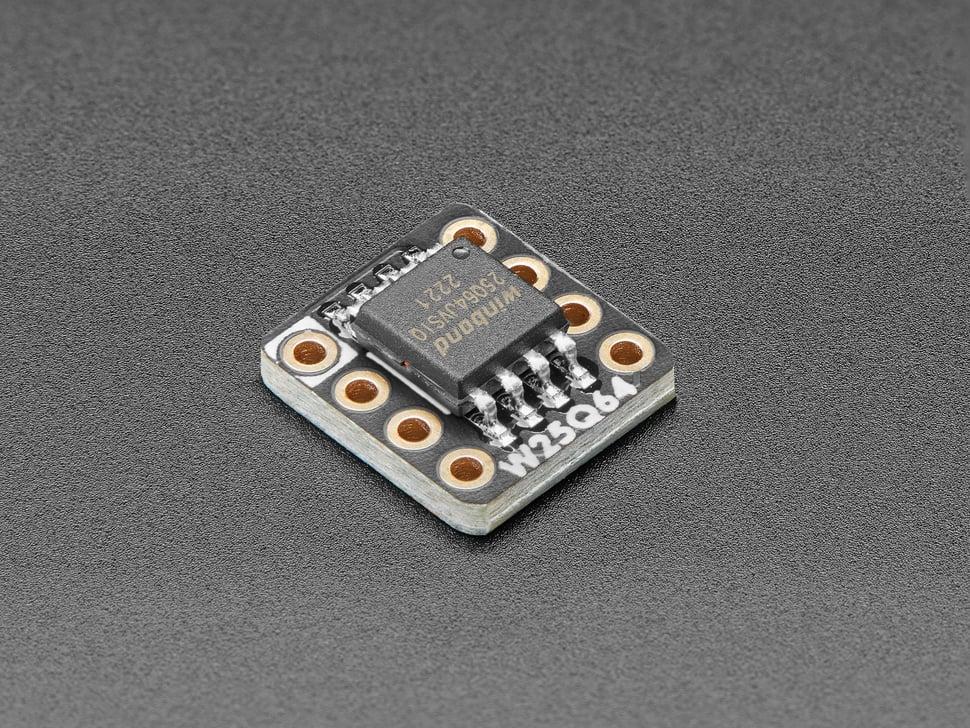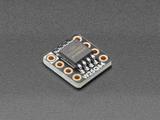Adafruit QSPI DIP Breakout Board - W25Q64 - 64 MBit 8 MByte

Description
For many modern and powerful chips like the RP2040, ESP32, RT10xx, and STM32 series microcontrollers, designers can save money and reduce the number of chip options by not including built-in Flash memory for storing code and resources. Instead, an external QSPI Flash memory chip is wired up, providing up to 16 Megabytes (128 Megabits) of memory.
It's not as fast as if it were on the microcontroller internal bus, but with Quad SPI I/O and some clever caching by the chip designer, it's quite effective. To make prototyping and designing with QSPI flash easier, these breakouts convert wide 8-SOIC packages to a compact 0.3" wide DIP, handy for testing different flash sizes or adding more storage to a project.
This is the W25Q64JVSSIQ, a 3.3V power and logic 64-Megabit / 8 Megabyte chip. The 'Q' at the end indicates the Quad Enable bit is permanently set in the status register. In QSPI mode, it works right out of the box. In SPI mode, the 'hold' and 'write protect' pins are non-functional, so connect them to 3.3V.
Compatible with the Adafruit_SPIFlash library in Arduino for 3.3V logic and power, or use a TOML definition file in CircuitPython for board definitions. Includes a bit of header for easy soldering and compatibility with breadboards or existing socketed SPI flash DIP chips.
Properties
| Brand | Adafruit |
| Model | 5633 |
Delivered in 10 to 30 days
Customer questions
Customer Reviews
- In stock Adafruit NOOds - Flexible LED Filament - 3V 300mm long - Red € 8,75 View product
- In stock Adafruit IR Break Beam Sensors with Premium Wire Header Ends - 3mm LEDs € 3,50 View product
- In stock Adafruit Breadboard-friendly 2.1mm DC barrel jack € 1,25 View product
- In stock Adafruit IR Break Beam Sensor with Premium Wire Header Ends - 5mm LEDs € 7,- View product
- In stock Adafruit Small Enclosed Piezo w/Wires € 1,25 View product
- In stock Adafruit Mini Basic PIR Sensor - BL412 € 2,50 View product
- In stock Adafruit Stainless Thin Conductive Thread - 2 ply - 23 meter/76 ft € 8,25 View product
- In stock Adafruit NOOds - Flexible LED Filament - 3V 300mm long - Blue € 8,75 View product
- In stock Adafruit 2 x CR2032 Coin Cell Battery Holder - 6V output - On/Off switch € 2,50 View product
- In stock Adafruit Pressure-Sensitive Conductive Sheet (Velostat/Linqstat) € 5,75 View product
- In stock Adafruit Stacking Headers for Feather - 12-pin and 16-pin female headers € 1,50 View product
- In stock Adafruit Stereo 3.7W Class D Audio Amplifier - MAX98306 € 10,50 View product
- In stock Adafruit Mono 2.5W Class D Audio Amplifier - PAM8302 € 4,75 View product
- In stock Adafruit White LED Backlight Module - Medium 23mm x 75mm € 3,- View product
- In stock Adafruit NOOds - Flexible LED Filament - 3V 300mm long - Lime Green € 8,25 View product
Recently viewed items
- Adafruit QSPI DIP Breakout Board - W25Q64 - 64 MBit 8 MByte € 3,25 View product
- Adafruit Atmega32u4 Breakout Board € 23,25 View product
- Adafruit Simple RF L4 Receiver - 315MHz Latching Selector Type € 5,75 View product
- Adafruit HDMI 4 Pi: 7" Display no Touchscreen 800x480 - HDMI/VGA/NTSC/PAL € 87,- View product
- Adafruit PaPiRus 2.7" eInk Display HAT for Raspberry Pi from Pi Supply € 58,- View product
- Adafruit Raspberry Pi 4 Model B - 2 GB RAM € 57,50 View product
- Adafruit NeoPixel UV LED Strip with 32 LED/m € 23,25 View product
- Adafruit LIS331 Triple-Axis Wide-Range ±24g Accelerometer € 12,75 View product
- Adafruit Love To Code: Volume 1 Add-on Booklet Kit € 5,75 View product
- Adafruit MACROPAD RP2040 Bare Bones - 3x4 Keys + Encoder + OLED € 40,75 View product
- Adafruit Raspberry Pi Build HAT Power Supply - 8V DC at 6 Amps € 17,50 View product
- Adafruit Kano Computer Kit with Touch Screen € 323,75 View product










